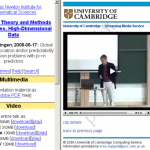Sequence logos are fun: www-lmmb.ncifcrf.gov is the ultimate site for many demo figures. It provides even a link where you can manufacture your own logo. Here is mine which is derived from a TCR consensus sequence:
Sequence logos are fun: www-lmmb.ncifcrf.gov is the ultimate site for many demo figures. It provides even a link where you can manufacture your own logo. Here is mine which is derived from a TCR consensus sequence:
Having been asked now by several people, I am compiling here a list of programs can be used for CNV calling. Continue reading CNV (not London) calling
The father of Mendelian Inheritance in Men died yesterday, one of the grand old men in Human Genetics. Go out for the plenty obituaries, for example at Johns Hopkins, Metro or Wikipedia.
 The Isaac Newton Institute for Mathematical Sciences has some interesting videos online – no need to travel – just sit back and relax, yea, yea.
The Isaac Newton Institute for Mathematical Sciences has some interesting videos online – no need to travel – just sit back and relax, yea, yea.
An (anonymous) reviewer of our forthcoming EJHG paper on IgE and STAT3 pointed me towards a JNCI paper that has a nice supplement – an excel sheet to calculate the probability that a positive report is false. It basically relies on (i) the magnitude of the p-value (ii) statistical power and (iii) fraction of tested hypothesis. While we certainly know (i) and (ii), (iii) is always hard to know with many datasets including hundreds of traits that allow indefinite numbers of subgroups. Are you really interested in a new paper about “An African-specific functional polymorphism in KCNMB1 shows sex-specific association with asthma severity” that encompasses 1 of virtually 100 ethnic groups; 1 or virtually 25000 genes; 1 of 2 sexes; 1 or virtually 50 asthma related traits, yea, yea.
A new Edge article answers this question. According to Chris Anderson, we are at “the end of science”, that is, science as we know it.
The quest for knowledge used to begin with grand theories. Now it begins with massive amounts of data. Welcome to the Petabyte Age.
Yesterday I reviewed a paper that crunches massive amount of data (and even found a new pathway for asthma). Nevertheless I was asking the question if this wishful thinking? Just take the next gene in one region and the overnext in another one and I would come up with a completely different pathway. This is all about association and not by the traditional “theorize, model, test it” way of science we have been brought along, yea, yea.
Wolfram Henn, Vorsitzender der Kommission für Grundpositionen und ethische Fragen der Deutschen Gesellschaft für Humangenetik, warnt im Interview mit Technology Review (Ausgabe 07/08 […]) vor persönlichen Genomanalysen, die über das Internet angeboten werden. So bietet beispielsweise das Unternehmen 23andMe seit kurzem eine Genomanalyse für nur 999 Dollar an.
Welcome in the club! Just to let you know that 23andme has been stopped 2 days ago as reported by Spiegel magazine.
genetic-future has an excellent article why the recent genome scans failed (i) alleles with small effects? (ii) population differences? (iii) epistatic interactions? (iv) cnvs more relevant than snps? (v) epigenetic inheritance? (vi) disease heterogeneity? It is a thorough review better than everything Continue reading The many problems of GWAs
Just for curiosity I am collecting a list of allergy genes that are vitamin D dependent. The list is already rather long but now there is a prominent addition: CD14. Known as asthma gene for many years the vitamin D dependency isn’t such clear. A clever analysis, however, now shows that there is an intermediate step involved Continue reading CD 14 now also on the vitamin+allergy list
… permanently leading to errors – the plus / minus strand orientation and the consecutive sequence / allele designation of SNPs. Only recently I came across a fancy way how to define strand direction – from a tech note Continue reading Orientation of genomic sequence and SNP allele designation
Occasionally I see high R^2 values even between linkage disequilibrium blocks. The following plot was obtained from the German asthma family study; basically a haploview screenshot rescaled and inverted before using the Photoshop polar filter. Continue reading Trans-border LD?
I am not sure if my count of sequenced individuals is correct. While the Human Genome Project and Celera used a DNA mix for their draft version of the human genome, the next genomes were provided by Watson and Venter. Numer 4 to 12 were Continue reading Women explained
Looking at the log file I found that an anonymous visitor was looking for “Jim’s DNA data” here. I thought of James Watson first. Obviously, however, the anonymous visitor was looking for something different: Continue reading Your DNA data here
The BBC headline yesterday is close to the famous quote of Neil Amstrongs’ with reporting the United States blocking now genetic discrimination.
Or as Kennedy put it forward “the first new civil rights bill of the new century”. Unfortunately, we are lagging behind in Europe. My recent initiative to promote such a legislative in Germany was futile; the most recent goverment proposal only earned a lot of criticism.